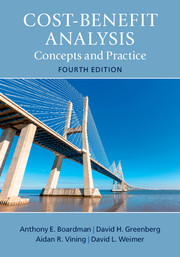Chapter 6 - Discounting Benefits and Costs in Future Time Periods
from PART II - FUNDAMENTALS OF CBA
Summary
Both private and public decisions can have important consequences that extend over time. When consumers buy houses, automobiles, or education, they generally expect to derive benefits and incur costs over a number of years. When the government builds a dam, subsidizes job training, regulates carbon dioxide emissions, or leases the outer continental shelf for oil exploration, it also sets in motion impacts that extend over many years. Often, analysts have to compare projects with benefits and costs that arise in different time periods. Formally, they have to make intertemporal (across time) comparisons. To do this, analysts discount future costs and benefits so that all costs and benefits are in a common metric—the present value. They can then measure and compare the net social benefits of each policy alternative using the net present value criterion.
This chapter deals with the practical techniques needed to compute the net present value of a project (or policy). It assumes that the social discount rate, the rate at which analysts should discount the future benefits and costs of a project, is known. As we discuss in Chapter 10, some controversy remains over the appropriate value of the social discount rate. In practice, though, oversight agencies, such as the Office of Management and Budget in the United States, Her Majesty's Treasury in the United Kingdom, or the Treasury Board in Canada, often specify the discount rate that analysts should use.
The sections of this chapter cover the following topics: the basics of discounting, compounding and discounting over multiple years, the timing of benefits and costs, comparing projects with different time frames, real versus nominal dollars, relative price changes, long-lived projects and calculating horizon values, time-declining discounting, and sensitivity analysis in discounting.
Appendix 6A presents some shortcut formulas for calculating the present value of annuities and perpetuities. The topics covered in this chapter are essentially uncontroversial. Readers who are familiar with the time value of money and capital budgeting techniques may want to skip this chapter.
THE BASICS OF DISCOUNTING
Projects with Lives of One Year
Technically speaking, discounting takes place over periods rather than years. However, because the discounting period is a year in almost all public-sector applications, and it is easier to think of years rather than periods, we generally use the term years.
- Type
- Chapter
- Information
- Cost-Benefit Analysis , pp. 133 - 166Publisher: Cambridge University PressPrint publication year: 2017



